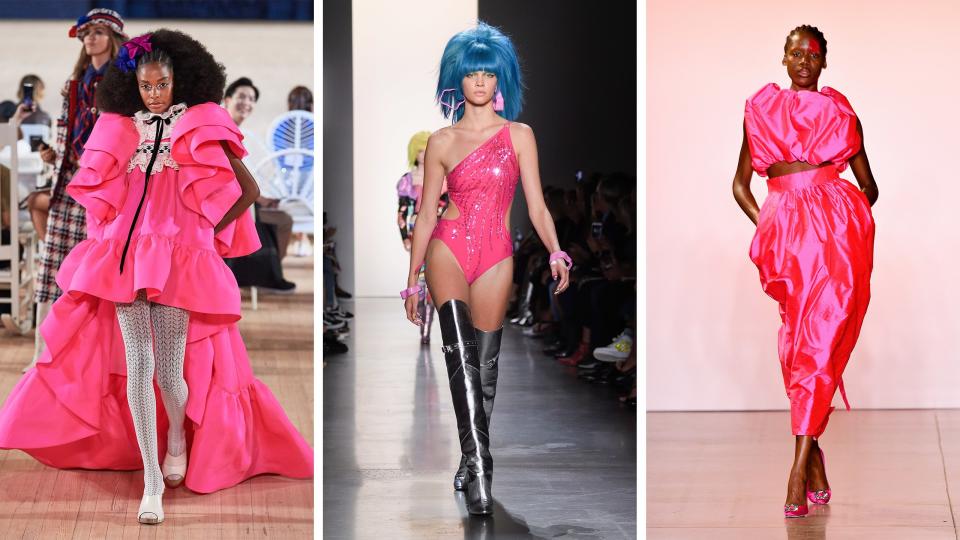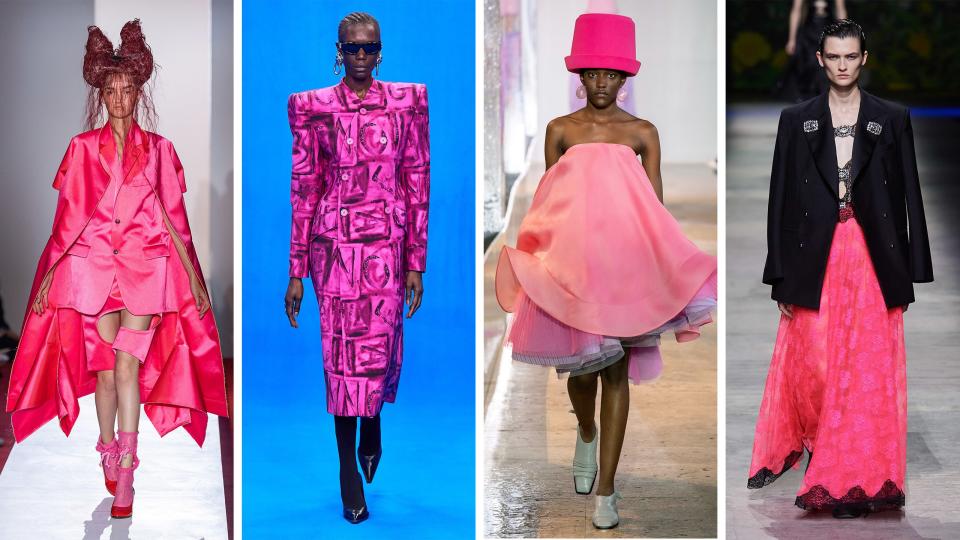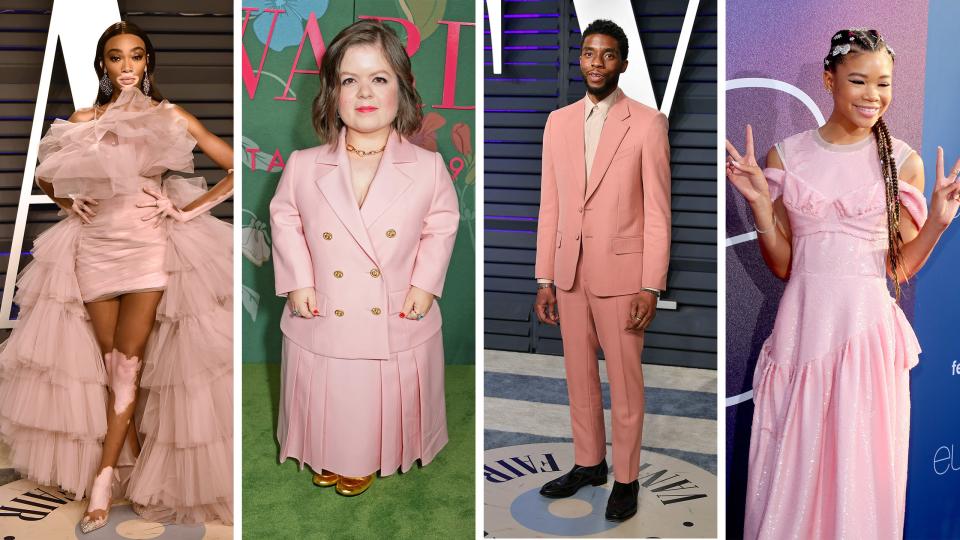Hot Pink Had a Major Moment During Fashion Month 2019
Pink is having a major moment. But it’s not that muted or dusty baby pink hue — aka millennial pink — we’ve been seeing for the last several years. You know, the one plastered across the walls of every chic café and restaurant, worn by VSCO girls and hype beasts alike. Instead, it’s a bold, saturated magenta color (also called fuchsia or hot pink) that makes an outfit seriously pop, whether it’s used as an accent color or iterated in a full head-to-toe look. And during the spring/summer 2020 fashion month, we saw shades of it popping up all over, from Collina Strada’s show in New York, where models perused a farmers market, to Off-White’s show during Paris Fashion Week, where models Gigi and Bella Hadid and Alek Wek posed together backstage in entirely hot pink fits.
The hue, which is actually the same color used by Planned Parenthood, is a garish, nostalgia-tinged version of pink that seems to be millennial pink’s younger, louder sister. It’s a highly commercial color that reminds me of my childhood, conjuring up images of the pink Power Ranger, scrunchies I wore as a little kid, all things Lisa Frank and Limited Too, a Barbie car I got for Hanukkah in third grade, and my favorite chewing gum as a child (Bubble Tape gum). Seeing the color makes me smile and feel a jolt of joy, which is not unlike the clothes we’ve been seeing as of late.
In the months leading up to the latest fashion month, I had already noticed the hue, which feels youthful and aggressively feminine, slowly spreading across my Instagram feed. Back in February, Rodarte showcased a range of ruffled and tulle dresses with glitter bows in the hue for its fall/winter 2019 collection, while in June, Storm Reid wore a half-zip sleeveless Prada knit top in the hue, pairing it with green eyeliner. A few weeks later, SZA dyed her hair a slightly lighter, more neon version of the color, debuting her new do on the gram with a Tweety Bird shirt in the same hue.
Kylie Jenner has also been rocking the color for a while. For instance, during her #KylieSkinSummerTrip, she and her pal Anastasia Karanikolaou wore matching Chanel dresses in a darker version of the tone while playing tennis, and later, for her 22nd birthday celebration, she wore a feathered magenta frock. Beyond this, I’ve also seen the color worn as eye shadow, blush, and lipstick. Naturally, JoJo Siwa is already a major fan of the girly color.
The color is quite possibly the standout hue from this season’s runways. In New York, it appeared at Jeremy Scott’s show in the form of a sparkly bodysuit with cutouts, at Christopher John Rogers as a voluminous satin top and bottom worn with matching heels, and at Marc Jacobs as an exaggerated ruffled dress. Across the pond, we saw it appear at Christopher Kane’s show in the form of a lace dress, and later in Milan at Gucci, as a girlish peacoat made edgy with black belted closures.

In Paris, it was spotted several times: A model at Comme des Garçons wore an abstract suit in the hue with matching lace socks, the Nina Ricci show featured a literal bucket hat in the color, and Balenciaga showed off a neon iteration in a suit dress. With high fashion, celebrities, and social media adopting the hue, it’s only a matter of time before we start seeing the color literally everywhere. But what might this uptick in all things magenta mean? Before we dive in, let’s first unpack where the color pink originated from.

In 2018, Valerie Steele, director of the Museum at the Fashion Institute of Technology and the author of Pink: The History of a Punk, Pretty, Powerful Color, told CNN, “Pink has always been a color in transition, and so have social attitudes towards it.” As the usage of the color pink has changed over time, so too has our cultural perception of it. According to the outlet, pink first grew fashionable in the mid-1700s, when male and female aristocrats from Europe wore “faint, powdery variants as a symbol of luxury and class.” In fact, by 1757 Madame de Pompadour, the chief mistress of Louis XV of France, was so enamored with the color that a French porcelain manufacturer named a new shade of pink after her, calling it “Rose Pompadour.”
In those days, pink was not reserved for girls. While babies of both sexes wore white, CNN claims that the hue was “often considered more appropriate for little boys because it was seen as a paler shade or red, which had ‘masculine,’ military undertones.” The connection between pink and femininity didn’t originate until the mid-19th century, as Steele argues that “men in the Western world increasingly wore dark, sober colors,” thus giving women brighter, more pastel options. According to her book, it was around this time that the color started to develop feminine and erotic connotations — pink suggested nakedness — with lingerie in shades of the hue becoming more popular, reflecting the art and literature of the time period.
From there, pink became a more popular color, with industrialization allowing the advent of cheap colored dyes, including magenta. “Pink went from luxury to working-class and, as a color often worn by prostitutes at the time, from sophisticated to vulgar,” the article says. Then, from the 1900s to the 1920s, high fashion readopted the hue with dresses by famed French designer Paul Poiret made in pastel pink hues in addition to cherry, coral, and fuchsia tones. Once the 1950s rolled around, CNN reports that pink was officially “gender-coded” via postwar American marketing, which sold the hue as an icon of hyperfemininity, a notion that has impacted the ways we perceive color all the way to today.

While we’ve witnessed several subtle cultural shifts in the color’s connotations over the last 70 years, millennial pink is perhaps the most famous pink hue of our recent times, which began making waves circa 2016. From a more salmon color (think Acne Studios’ logo) to a dustier light pink (think Glossier’s Balm Dotcom), the color has become synonymous with millennials who drink rosé and spend all of their money on avocado toast. But also, it has helped give a previously saccharine color, which had once been passé and reserved for little girls, a new identity — millennial pink has come to represent something cooler and more androgynous. In all its glory, it has been a timely color given the contentious state of gender and sexuality.
And now, hot pink appears to be the next and natural chapter in pink’s cultural evolution. As we head into the next presidential election knowing what we know now, the color seems to do two things: help alleviate how people feel about the doom and gloom of the world while also asserting its joyful femininity in a way that feels over-the-top and totally necessary. It’s a nice, playful alternative to red, which has long been tied to power in the eyes of men (for example, one could argue that red lipstick asserts femininity in a man’s world). In our trying times, magenta feels refreshing and seems to say: We know we’re shocking, but don’t worry, you’ll warm up to us soon.
Originally Appeared on Teen Vogue

